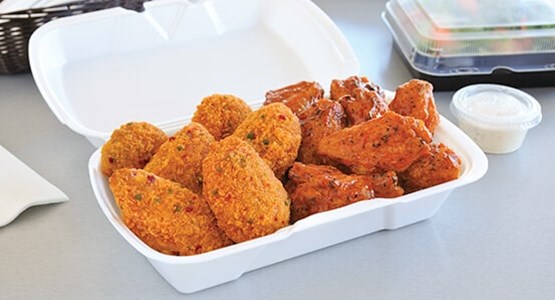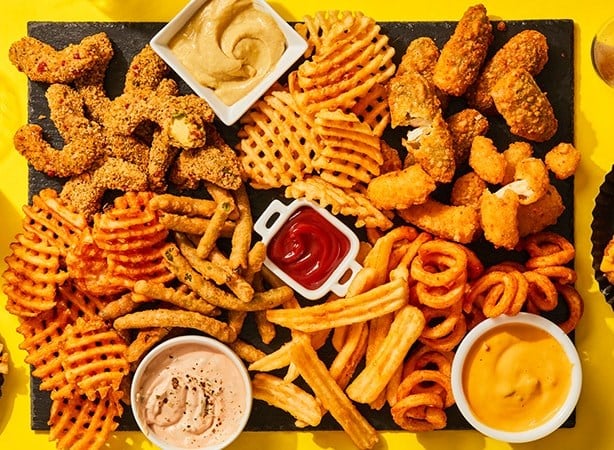
Now more than ever consumers are seeking comfort foods they can share at home with their families.
Offering their favorite, feel-good restaurant items, such as burgers, fries and appetizers, will remind them of the better times when they were able to enjoy dining out together. Even if they don’t routinely appear on the menu, these types of items can also help support operators’ margins during these challenging times.
In many cases, operators may be feeding entire families, so offering a diverse menu can help satisfy everyone and avoid the “veto” vote.
Offering a Diverse Menu
At American Elm in Denver, the company has combined its bistro menu with that of its food truck and a new concept it recently created called Neighborhood Noodles. As a result, customers can mix and match among the different offerings for takeout or delivery. American Elm had already been serving as a commissary kitchen for its food truck, called Kings County Kitchen, which offers a variety of fried foods, sandwiches, burgers, tacos and appetizers.

“You could get a steak from American Elm for yourself, a pasta dish for your wife and then mozzarella sticks and cheeseburgers for your kids”
In addition, the restaurant launched a meal-kit plan so that customers can order pre-cooked, oven-ready meals for one, two or four people. It is planning to make basic grocery items available for delivery and takeout as well.
“It comes as no surprise that dishes commonly found in the cadre of ‘comfort foods’ are doing well at the moment, given our collective desire for comfort in a time of ambiguity,” says Aaron Novoshen, founder and CEO of restaurant consulting firm The Culinary Edge and chicken-sandwich chain Starbird.
He notes that shareable foods can also provide a way to foster connection among homebound families.
“Meals with family, significant others or roommates can restore our sense of community and connection,” says Novoshen. “All hail the chicken wing basket!”
Catering to Families
Denver-based Breckenridge-Wynkoop, which is offering takeout from several casual restaurants in Colorado, is conducting a different family meal promotion each day offering mostly comfort-food bundles featuring main dishes, sides, bread and dessert. The meals can feed two, four, six or eight people, priced at $10 per person.
“It changes every day based on what the chef wants to cook up,” says Amanda Young, director of operations at the restaurant company. She says that family meals for four have been especially popular.
Young notes that comfort foods have long been at the core of all of the concepts, but during the crisis consumers have been particularly hungry for items such as burgers, macaroni and cheese bites and meatloaf at the company’s The Cherry Cricket locations.

“People are looking for a ‘hug’ in their food, and that’s what we are aiming to give them"
One dish in particular that has been a big seller at The Cherry Cricket is a basket of fries and onion rings combined that it calls “Frings.”
“That’s probably our most requested dish,” Young says. “It’s not your typical side — and it’s shareable for the entire table.”
Group dining is the focus of the menu at Mexicue, the New York-based restaurant chain that recently transitioned to in-house delivery. Its new “MexiCrew” meals, designed especially for takeout and delivery to groups, include Family Meal Tacos for four and a Happy Hour special for 10 with four types of tacos, tortilla chips with a trio of dips, grilled cornbread and a margarita mix. Other meal combos are designed for two, six or eight people.
“It's just one click and you get all this food,” says Scott Landers, co-founder of delivery consulting firm Figure Eight Logistics, which helped launch the in-house delivery program at Mexicue. “Plus, your delivery economics are so much better if you have an average check size north of $50 instead of $25. It's an entirely different ballgame.”
Have Food, Must Travel
It’s also important to think through how the entire menu can withstand the rigors of travel for off-premises consumption, he says. For example, avoid mixing temperatures in the same container, and package sauces and dressings on the side.
“You have think about what that food going to look like after it's traveled for 10 to 20 minutes,” Landers says.
Where it’s allowed, operators might also consider interesting ways to bundle alcohol purchases with meals, he suggests.
“Think of shareable experiences that fit your cuisine type and allow customers to focus on the shared activity, not just on the fact that there is a global pandemic going on,” he says.

